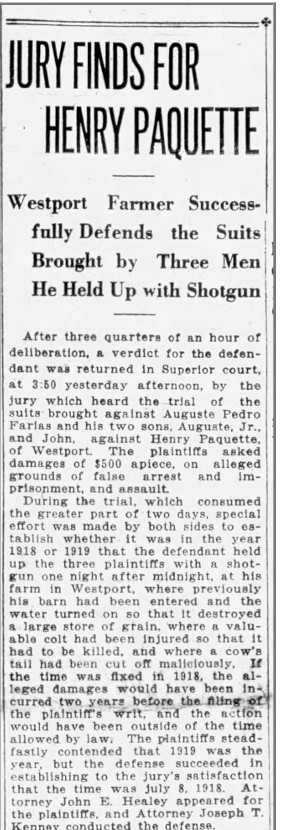The Mystery of the Hillandale Milk Bottle
Posted on June 11, 2025 by Jenny ONeill
By Jane Dufault
In 1980, we purchased land, one half mile from the Head of Westport off Drift Road, and had our home built by Dick Wertz. This land and road eventually became known as Sisson Farm Lane. It was named this as the first settler; Richard Sisson had built the first home in Westport a short distance from our home in the 1660’s.
Dick, being a history professor at MIT in Boston loved history and wanted the 60 acres of land he had purchased to be filled with historic homes. Our home was originally a 1740’s post and beam home from Bridgewater, Mass. from an area referred to as Scotland. The farmhouse was part of a dairy farm. The “ell” had been bulldozed down first before someone had contacted Dick to see if he would be interested in dismantling the home and relocating it. He decided to do it and took pictures as they painstakingly took it apart. I visited the Bridgewater library in an effort to find out something about the house and found a picture of the farm with cows in the background. Dick researched the home and said it was built in 1740 by Caleb Fobes.
Fast forward to landscaping our front yard in 1980. I decided the two huge rocks were a nice area to plant hostas and shrubs. As I dug in the dirt, I kept pulling out rocks. Luckily Dick was here one day and saw what I was doing. He proceeded to tell me he had filled that area in with “rocks” as it was part of a rock quarry and it went down 20 ft. We decided just to add more dirt so we could plant.
Interesting Fact: History states the rocks from this quarry were used to build the stone wall at the Stone House at the Head of Westport. Stephen Howland ran out of money and it was never finished. There is still a rock slab that was cut and never removed.
As I worked on the surrounding hill area that was filled was weeds, I kept finding all sorts of “junk” that you would find in a landfill. Dick proceeded to tell me this area was the dumping grounds for the farmhouse just below us back in the day. That made a lot of sense. Being interested in “old” things, I kept a box with all these treasures. The more I dug, the more I found, especially lots of broken glass. These pieces were mostly from bottles…milk bottles to be exact.
Somehow, out of complete luck I found an intact pint size milk bottle. The inscription on it was: Hillandale Dairy Farm Westport, Mass.
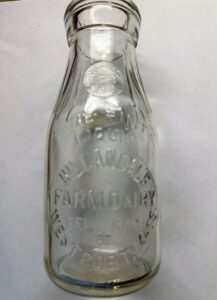 I inquired with the Westport Historical Society about the bottle and they posted it in their newsletter in an effort to find out some information about the dairy farm. I spoke to “old-timers” in town hoping they would recall the name. However, I had no luck. Evidently, there were as many as 400 dairy farms in town at one time.
I inquired with the Westport Historical Society about the bottle and they posted it in their newsletter in an effort to find out some information about the dairy farm. I spoke to “old-timers” in town hoping they would recall the name. However, I had no luck. Evidently, there were as many as 400 dairy farms in town at one time.
Now fast forward to January 2025 and the benefit of social media…
The Westport Historical Society decided to do a summer exhibition at the Handy House about farming in Westport. My paternal grandparents, Joseph and Victoria Ziemba (Zembo) owned a farm on Gifford Road, so I became involved. My cousin Frances had found photo albums in the hayloft years earlier but unfortunately after all our relatives had passed. They were filled with farming photos that I shared with the historical society.
I attended the open house they had at the Westport Grange where all the locals were encouraged to come and share photos and knowledge about their farms. A few people thought they had heard of the Hillandale Dairy Farm so I decided to post a picture of the bottle now that we had social media available.
I quickly got a response from Robin Winters, who specializes in local history at our Westport Library. She had found some info for me! Little did I know how that information would turn into intense weeks of researching.
Robin had found references to the “Hillandale Dairy Farm” in two separate postings in the newspapers. The first was in the Fall River Daily Evening News on August 30, 1920 about selling pigs.
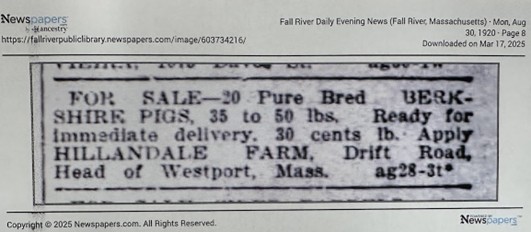
The second was an ad in the Evening Herald (Fall River, Massachusetts) on Saturday, June 25, 1921 to see the farm. We think the “10-acre” was a possible error as all the research has shown the farm consistently sold as 90 acres.
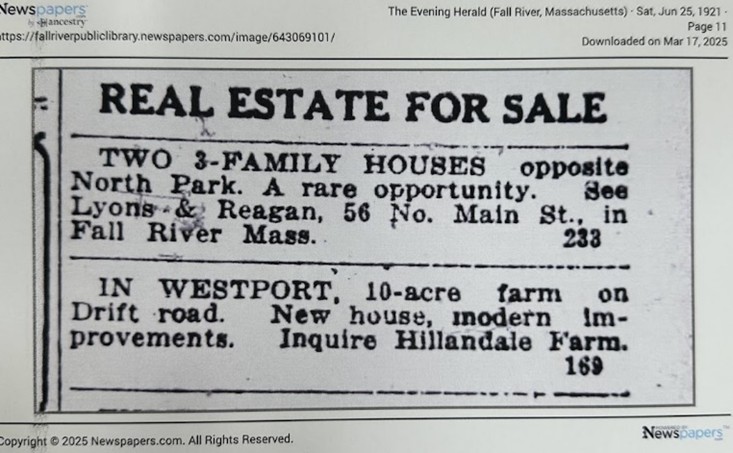
My quest for the week was to find out if the 60-acre Sisson Farm property purchased by Dick Wertz could have been part of the original 90-acre Hillandale Dairy Farm. Current research seems to indicate 30 acres were sold in the 1930’s and Dick Wertz purchased the remaining 60 acres in the late 1970’s. This seems to be the most probable conclusion.
After several days of research and countless hours at the library with Robin, Jenny O’Neill, director of the Westport Historical Society, sent me an email with information she found in the Berkshire Bulletin in 1920.
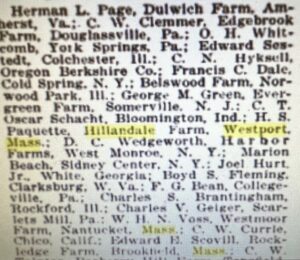 We finally had a name to put to the Hillandale Dairy Farm…Henry S. Paquette!
We finally had a name to put to the Hillandale Dairy Farm…Henry S. Paquette!
To say Robin and I were elated was an understatement! We quickly found more information and it just came pouring in.
Henry Servule Paquette bought the property to be known as Hillandale Farm from Hannah F.L. Hatch on January 17, 1916. This following information was found in the Bristol County Registry of Deeds:
1 -17-1916 Hannah L. F. Hatch to Henry S. Paquette Vol. 430 p. 351-352 (Hillandale Dairy Farm)
2-28-1922 Henry S. Paquette gave ½ interest of land to father, Servule Paquette, still had mortgage to finish paying
2-28-1922 Henry S. Paquette et al sold 90 acres back to Hannah L. F. Hatch
One question we pondered was how the name, “Hillandale” had been chosen for the dairy farm. Robin Winters had an educated guess that appears to be quite accurate. She divided the name so it read “Hill and Dale.” The northwest edge of the 60 acre Sisson Farm property is now called Sisson Hill Lane. If one stands here and looks towards the southeast down Sisson Farm Lane, the property heads downward towards the Westport River. This would be the “dale” or valley, hence the name “Hillandale.” According to land records, the property line crossed Drift Road and went all the way to the Westport River.
Dating the Hillandale Milk Bottle
Attempting to date the milk bottle was another important step in confirming when the Hillandale Farm existed.
 First, we looked at the seams along the sides of the bottle. In newer bottles, the seam extended to the top. However, in this bottle the seam stopped at the top of the bottle. It was also unique as it had “lines” spaced vertically about ½ to ¾ inch apart along the neck of the bottle.
First, we looked at the seams along the sides of the bottle. In newer bottles, the seam extended to the top. However, in this bottle the seam stopped at the top of the bottle. It was also unique as it had “lines” spaced vertically about ½ to ¾ inch apart along the neck of the bottle.
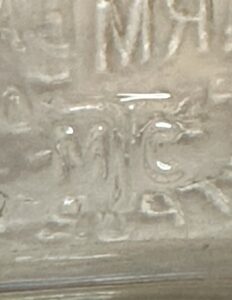 There was a circular seal in the front center of the bottle with the words, Mass. seal and the letter “T” in the center. This Massachusetts seal was required to be on all glass bottles produced in glass factories for dairies here from 1909 to 1947. This seal also indicated the bottle was produced by the Thatcher Manufacturing Company (TMC). The back of the bottle at the bottom also had the symbol, MTC with the letters, M and C made smaller and the T larger and in the center. This was commonly found on bottles made from 1920-1923.
There was a circular seal in the front center of the bottle with the words, Mass. seal and the letter “T” in the center. This Massachusetts seal was required to be on all glass bottles produced in glass factories for dairies here from 1909 to 1947. This seal also indicated the bottle was produced by the Thatcher Manufacturing Company (TMC). The back of the bottle at the bottom also had the symbol, MTC with the letters, M and C made smaller and the T larger and in the center. This was commonly found on bottles made from 1920-1923.
The letters E and L were also used later once the Thatcher Manufacturing Company acquired Lockport and Essex in 1920.
The bottom of the bottle also had a clear circular valve mark with the letter E in the center. This dates the bottle from 1910-1940. This marking was the result of the press and blow method commonly used by the manufacturing company at that time.
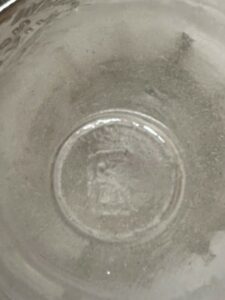 The bottom heel had the symbol, H 11 in front, the number once again referring to the Thatcher Manufacturing Co.
The bottom heel had the symbol, H 11 in front, the number once again referring to the Thatcher Manufacturing Co.
 Lastly, the front of the bottle bore the name, Hillandale Westport, Mass. in a circular pattern with the words, Farm Dairy horizontally across the center. We felt comfortable dating the bottle in the early 1920’s which matches the time that Henry S. Paquette lived in Westport on Drift Road at the Head.
Lastly, the front of the bottle bore the name, Hillandale Westport, Mass. in a circular pattern with the words, Farm Dairy horizontally across the center. We felt comfortable dating the bottle in the early 1920’s which matches the time that Henry S. Paquette lived in Westport on Drift Road at the Head.
Newspapers from the Archives
As our research continued, Robin began finding numerous articles about Henry Paquette on the internet from old newspaper articles. I immediately subscribed to newspapers.com and began to learn more about Henry and his family. I also searched his name on Ancestry.com and found a living relative, Robert Paquette living in Rhode Island. Henry was one of his grandfather’s brothers.
Some of the interesting highlights of our research:
- Born July 31, 1886 in Farnham, Brome-Missisquoi, Quebec, Canada to Serville Paquette (1860-1938) and Auda Suprenant (1865-1936)
- Immigrated to USA in 1893
- Lived on Mattapoisett Road in Acushnet in 1900. Oldest of 13 children…7 sons and 6 daughters—Henry, Joseph, Alice, Charles, Agnes, Yvonne, George, Oscar, Herve, Arthur, Blanche, Juliette, Jeannette. Listed as a student for nine years, can read, write and speak English.
- Married August 29, 1910 in Fall River, Mass. to Maria Jeanne J. Lemieux at age 24. Lived in Acushnet, Mass.
- Lived in Dartmouth in 1915, occupation: milkman
- Henry purchased a 90-acre farm at the Head (on Drift Road) on January 28, 1916 from Hannah Hatch.
- Henry listed in 1920 census in Westport, managed farm, house owned but mortgaged, native tongue French, naturalized citizen, had four children…Lorenzo, F. Edward, Raymond, Lucille
- Sold property back to Hannah Hatch on February 18, 1922.
- Henry listed in 1930 census as living in Central Falls, Rhode Island and in 1935 as in Pawtuckett, R.I.
- Henry is listed in the 1940 census as living in Taunton, Mass. with his wife M. Jeanne on Somerset Ave. His occupation was engineer, he owned his home, and completed grades 1-8
- Henry died May 6, 1963 in Pawtucket, Rhode Island. His wife, Maria Jeanne Lemieux died in 1970.
As we researched we found many newspaper articles highlighting Henry’s expertise in raising Berkshire swine. He was well noted and highly regarded in many articles winning many awards at the Westport Fair.
Some important highlights during Henry’s residence in Westport, Mass.:
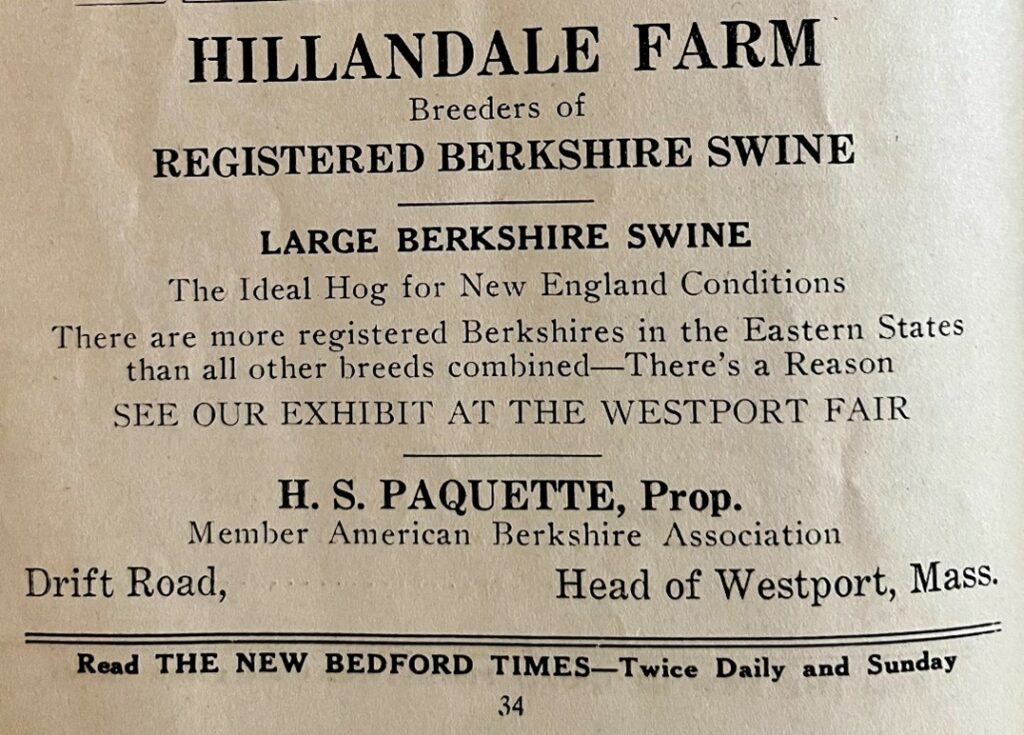
- Fall River Daily Evening News Farmer’s Day at the Westport Fair…
Thursday, September 25, 1919
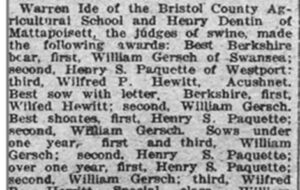
- Fall River Daily evening News Friday, September 17, 1920

- Fall River Daily Evening News Westport Fair Thursday, Sept. 28, 1922
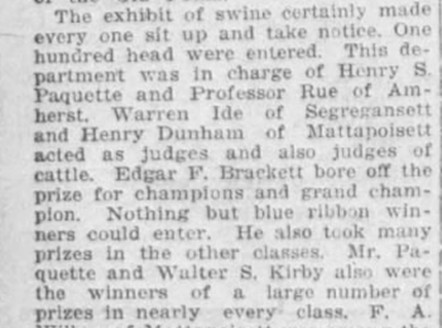
- The Evening Herald Westport Fair Wednesday, September 26, 1923

Family photos of the Paquette family:
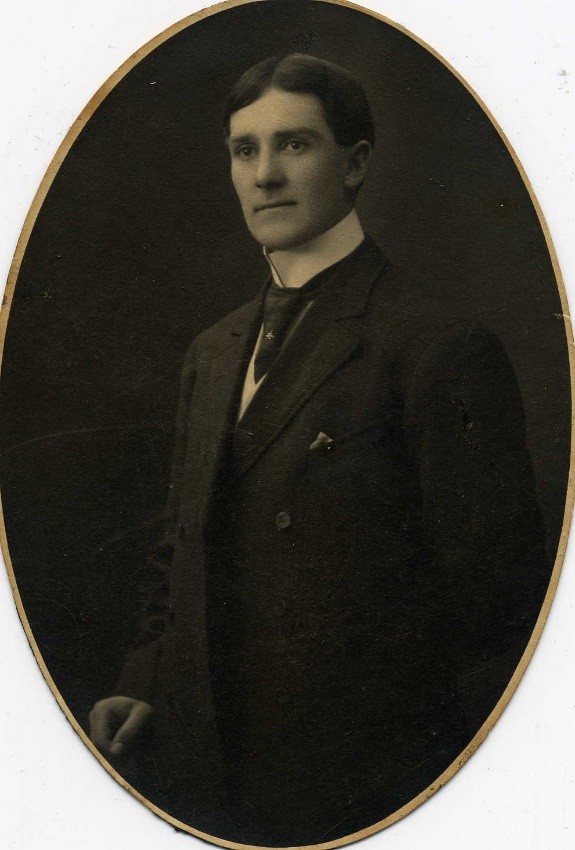
Henry Paquette

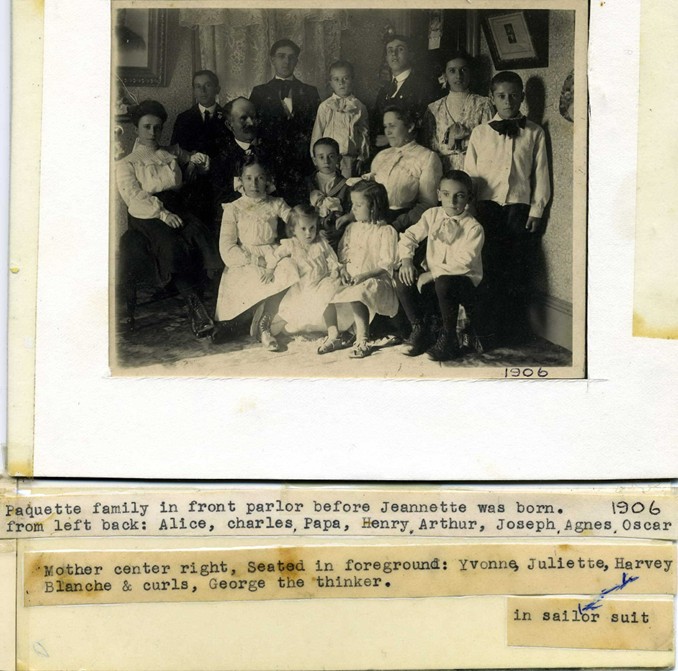

Henry Paquette seated front row on the far left. Parents, Servule and Auda Paquette in center.
Interesting Event: Our research on the Hillandale Farm brought us to some disturbing articles in the Evening Herald, Fall River Daily Evening News, and Fall River Globe, (Fall River, Massachusetts) in 1918 and later in 1923.
This article appeared on Wednesday, July 10, 1918 in the Fall River Globe.
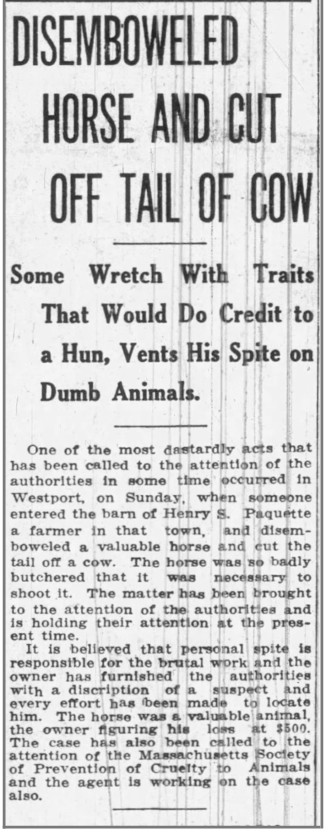
July 9, 1918, Henry Paquette was awakened by his barking dogs around midnight and found three men, Auguste P. Farias and his two sons, Auguste, Jr. and John P. Farias near his piggery. They had iron bars, a hoe, burlap bag and flashlights. Henry had been the subject of several malicious attacks on his farm just prior to this. Grain had been destroyed from someone turning on water in the barn, the water piping in his barn had been maliciously put out of commission, and two animals had been cruelly maimed. He immediately considered them suspects.
According to the Fall River Daily Evening News, “When they made unsatisfactory answers as to their presence in that locality at that hour of the night, Paquette marched them into his barn at the muzzle of his shotgun and with the aid of his hired man, armed with a revolver, tied the hands of the three men and started with them in his auto truck for a police officer.” Constable Shorrock was contacted and met them at Lincoln Park. The prisoners were taken to the New Bedford Police Station but not finding sufflicient evidence to lock them up, they were returned to Lincoln Park and released.
Auguste Farias and his sons eventually sued Henry Paquette for $500 apiece allegedly accusing him of false arrest, assault, and false imprisonment. This went to trial in September 1923. According to the Evening Herald, this was Auguste Farias’ testimony as to why they were on Henry Paquette’s property:
The Evening Herald
Tuesday, September 25, 1923
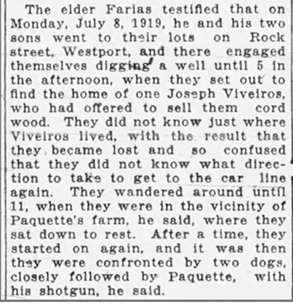
The jury returned a verdict in favor of Henry Paquette within 45 minutes as the time limit to file by law had been exceeded by Auguste Farias and his sons.
The Evening Herald
Wednesday, September 26, 1923
